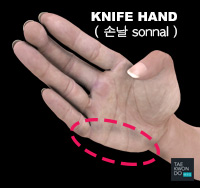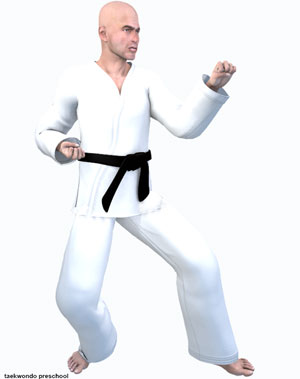Taekwondo 태권도Taekwondo Preschool
Promotion from one geup to the next can proceed rapidly in some schools, since schools often allow geup promotions every two, three, or four months. Students of geup rank learn the most basic techniques first, and then move on to more advanced techniques as they approach first dan. Many of the older and more traditional schools often take longer to allow students to test for higher ranks than newer, more contemporary schools, as they may not have the required testing intervals. View Taekwondo belt levels »

Promotion Tests | Yellow Belt
Yellow Belt Level Information
Meaning: "Signifies the earth from which a plant sprouts and takes root as the foundation of taekwondo is being laid"
Style: World Taekwondo (WT) 
Ranking: 8th geup
Difficulty Level: Beginner
To advance from one rank to the next, students typically complete promotion tests in which they demonstrate their proficiency in the various aspects of the art before their teacher or a panel of judges. Promotion tests vary from school to school, but may include such elements as the execution of patterns, which combine various techniques in specific sequences; the breaking of boards to demonstrate the ability to use techniques with both power and control; sparring and self-defense to demonstrate the practical application and control of techniques; physical fitness usually with push-ups and sit-ups; and answering questions on terminology, concepts, and history to demonstrate knowledge and understanding of the art. For higher dan tests, students are sometimes required to take a written test or submit a research paper in addition to taking the practical test.
Promotion from one geup to the next can proceed rapidly in some schools, since schools often allow geup promotions every two, three, or four months. Students of geup rank learn the most basic techniques first, and then move on to more advanced techniques as they approach first dan. Many of the older and more traditional schools often take longer to allow students to test for higher ranks than newer, more contemporary schools, as they may not have the required testing intervals. More information View Belt Level Ranking »
Difficulty of Promotion Test
Taekwondo students of geup ranking learn the most basic techniques first, and then move on to more advanced and difficult techniques as they approach 1st Dan Black Belt. The more difficult the techniques, the more practice may be needed for the purpose of improving or mastering it, as in the phrase 'practice makes perfect'. Every technique must display the requisite speed, balance, power and firmness to be realistically used as an attack or defense move.

Highlight Knife Hand ( 손날 sonnal ) Posture
By tucking the thumb into the palm, a surface called the knife hand or hand blade ( 손날 sonnal ) is formed. The surface extends with the muscle at the side of the hand located between the base of the small finger and the wrist ( 팔목 palmok ). The hand blade is used as both an offensive and defensive technique which can be executed as a high, low, middle, side, inward, outward, rising or circular. Use of this technique as both a strike and block is featured prominently in many of the World Taekwondo (WT) Taegeuk Poomse.
* Please see a certified Master Instructor ( 사범님 sabeomnim ) for training. Proper guidance and instructions are needed to ensure safe training.
Taekwondo Promotion Tests | Yellow Belt

Yellow Belt Level Requirements
Style: World Taekwondo (WT) 
( Techniques vary between schools )
Blocks ( 막기 makgi )
Stance ( 서기 sogi )
- Walking Stance ( 앞서기 ap-sogi )
- Front Stance ( 앞굽이 ap-kubi )
- Fighting Stance ( 겨루기준비 gyeorugi-junbi )
- Parallel Stance ( 나란히서기 naranhi-sogi )
- Inward Stance ( 안쫑서기 anjjong-sogi )
- At Ease Stance ( 편히서기 pyeoni-sogi )
Fist Strikes ( 지르기 jireugi )
- Double Punch ( 몸통 두번 지르기 dubeon-jireugi )
- Rear Hand Middle Punch ( 몸통 바로 지르기 momtong-baro-jireugi )
- Low Punch ( 아래 지르기 arae-jireugi )
- High Punch ( 올려 지르기 olgul-jireugi )
Kicking ( 차기 chagi )
- Roundhouse Kick ( 돌려차기 dollyeo-chagi )
- Instep Turn Kick ( 발등 돌려차기 baldeung-dollyeo-chagi )
- Back Kick ( 뒤차기 dwi-chagi )
- Reverse Side Kick ( 반대 옆 차기 bandae-yeop-chagi )
- Flying Kick ( 두발당성차기 dubaldangseong-chagi )
- Front Foot Kick ( 앞발 차기 apbal-chagi )
- Front Foot Front Kick ( 앞발 앞차기 apbal-ap-chagi )
- Front Foot Side Kick ( 앞발 옆차기 apbal-yeop-chagi )
- Front Foot Axe Kick ( 앞발 내려차기 apbal-naeryeo-chagi )
Poomse 품새
Poomse is the foundation for the teaching of Taekwondo. A poomse, or form, is a detailed pattern of defense-and-attack motions and techniques used in traditional martial arts. Poomse is useful in developing proper kinetics, mental and physical fortitude.
Most Kukkiwon schools will use the poomse taegeuk whereas a few schools will use the poomse palgwe. The meanings, trigrams and symbols are shared by both poomse taegeuk and poomse palgwe, however the sequence of movements is different. The first 8 forms of the set of poomse differ from each other, whereas the last 9 forms (Black Belt forms) of the set are shared between the two sets. All students studying in World Taekwondo (WT) Kukkiwon style must learn these forms, or taegeuk, to advance to a higher belt level. There are eight taegeuk forms, each one similar to the previous one, but each time with more complicated techniques to display the students' mastery of the techniques learned during lessons, as well as the ability to interconnect these techniques. For more information View Taekwondo Poomse 품새 »

Taekwondo Promotion Test
Testing or evaluation is important to taekwondo practitioners who wish to determine their progression or own level of skill in specific contexts. Students within individual belt levels often undergo periodic testing and grading by their own teacher in order to advance to a higher level of recognized achievement, such as a different belt color. View Taekwondo Promotion Tests »
* Please see a certified Master Instructor ( 사범님 sabeomnim ) for training. Proper guidance and instructions are needed to ensure safe training.
There are five tenets defined in the International Taekwondo Federation (ITF) and several more in World Taekwondo (WT).
Perseverance ( 인내 in-nae ): "One will persevere time and time again until they have achieved a result which is adequate towards what one was trying to achieve." View Taekwondo Tenets »
RESOURCES
This article uses material from the Wikipedia articles "Taekwondo", "Taegeuk" and "Hyeong" which is released under the Creative Commons Attribution-Share-Alike License 3.0.


























